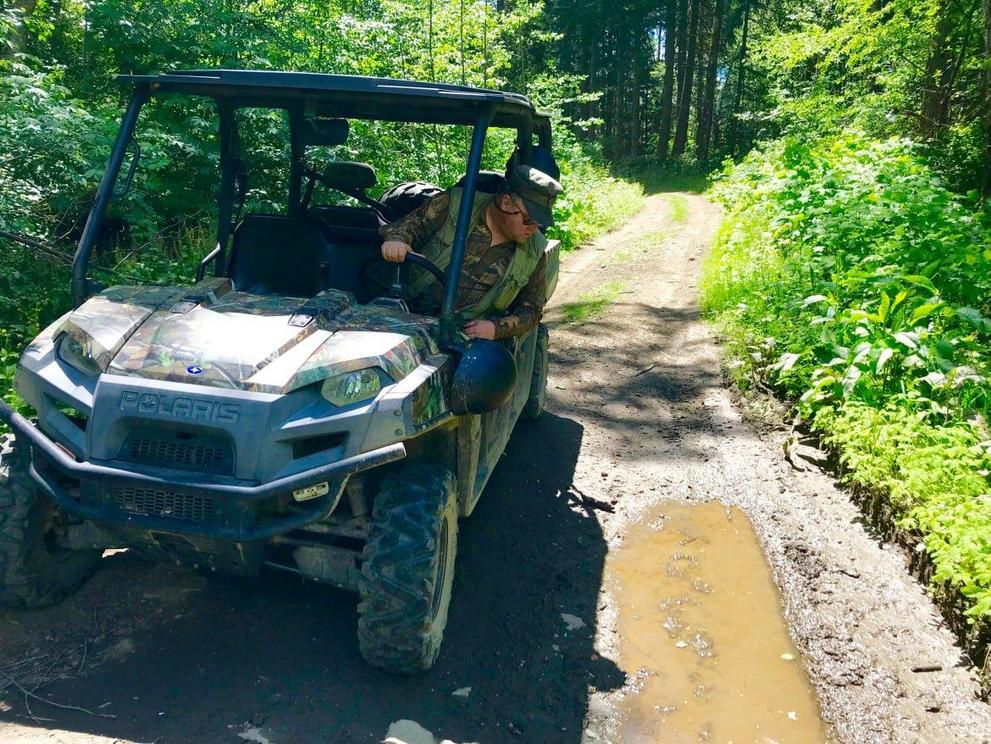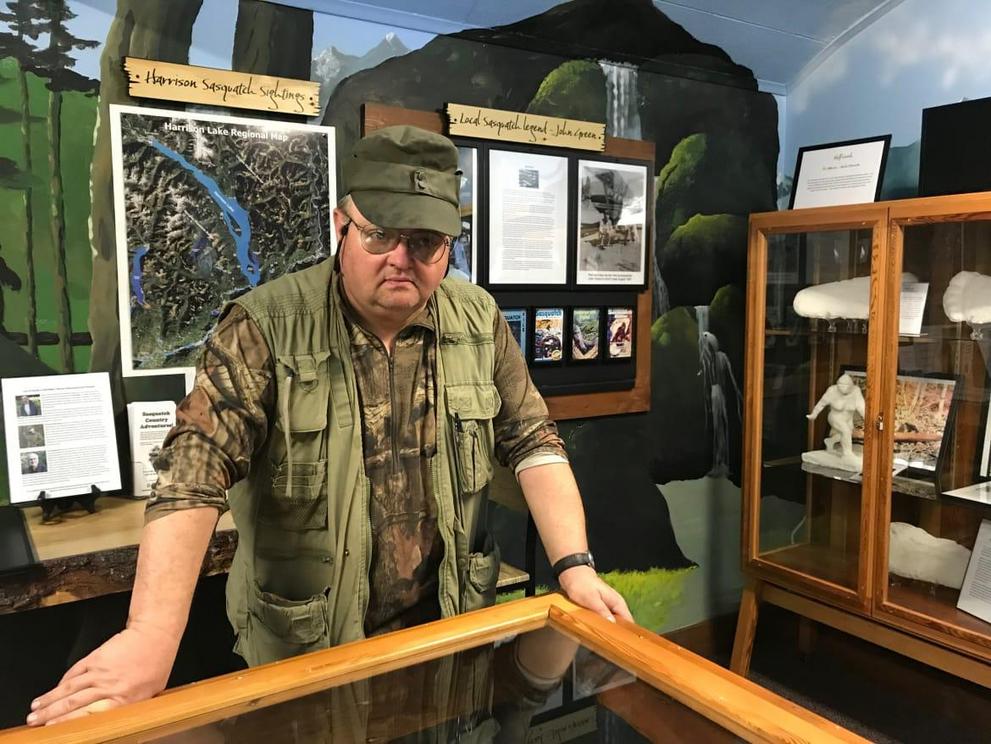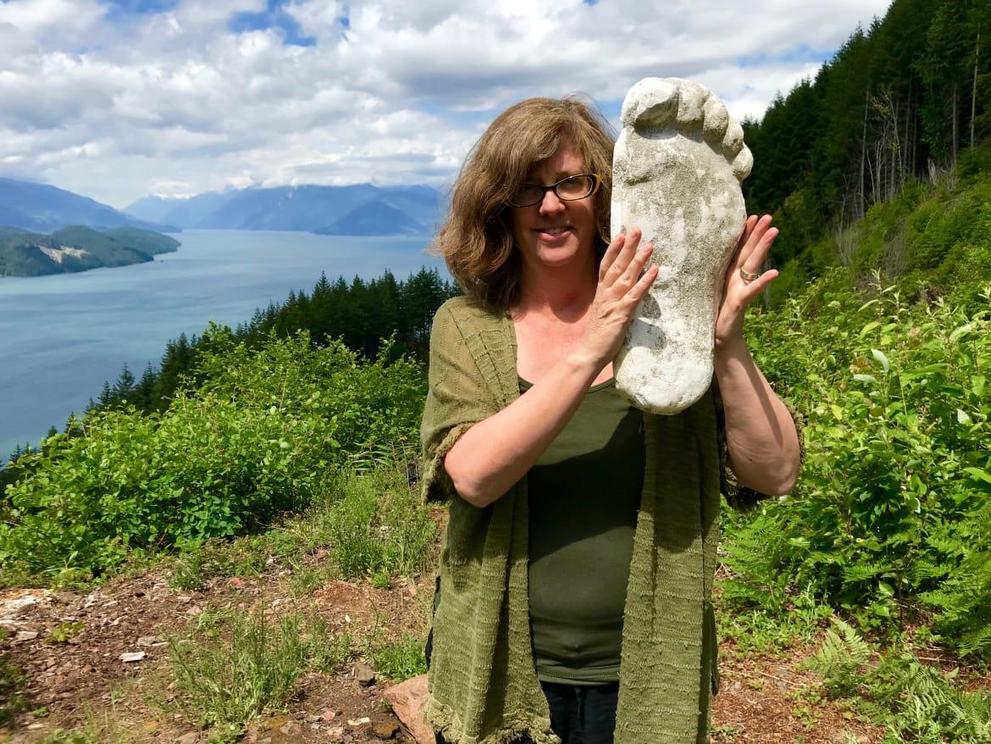Sasquatch hunting goes mainstream in small Canadian town
The legendary ape-like creature that it said to roam the forest in British Columbia finally gets a museum to go with a festival and backcountry tour.

With gritted teeth and a stern face befitting a former army man, Thomas Steenburg starts our Sasquatch-hunting wilderness tour in Harrison Hot Springs a couple hours east of Vancouver with a brusque disclaimer.
“Odds are you aren’t going to see anything. If we could guarantee seeing a Sasquatch, this mystery would be over.”

Courtesy Jennifer Bain
He then shares the golden rule of serious investigators.
“Thou. Shalt. Not. Hoax.”
Pausing for dramatic effect, he spits out the final word: “Ever.”
I was raised on the Sasquatch legend, dreaming that the huge, hairy, ape-like creature from British Columbia might sneak across four Canadian provinces to my cottage. I once dated an extra-tall guy nicknamed Sasq. Now, I’ve asked Sasquatch Country Adventures to show me the creature’s main stomping grounds, open my mind and maybe even blow it. No cheesy hoaxes needed.

Bill Miller, who owns the company but lives in Illinois, isn’t around, so Steenburg sets the meeting spot at the Husky gas station just past the new Harrison Sasquatch Museum.
People used to be embarrassed that this part of the Fraser Valley two hours east of Vancouver is the Sasquatch capital of the world. Now they see the tourism potential.
The museum opened during Sasquatch Days in June, an intercultural celebration that happened once in 1938 and then not again until 2012. Now, the village and the First Nations band Sts’ailes put it on annually, with war canoe races, medicine walks, salmon barbecues and Sasquatch storytelling.

Courtesy Jennifer Bain
The Sasquatch has been part of Sts’ailes lore for thousands of years as the primary caretaker that watches over the land and moves between the physical and spirit worlds. The word Sasquatch is believed to be a mispronounced, anglicized version of the Sts’ailes word “Sa:sq’ets.” The band’s trademarked logo features a black, red and white formline drawing of the hairy creature.
Americans, especially in northern California and along the west coast, know Sasquatch as Bigfoot. Sasquatch (or Bigfoot) is a cryptid, or a creature whose existence has been reported but not scientifically confirmed. People who research cryptids are cryptozoologists. In Asia, you have the Yeti or Abominable Snowman. Scotland has the Loch Ness Monster. And so on.
I hop in Steenburg’s Nissan XTerra to tow a Polaris Ranger side-by-side to the edge of Sasquatch Provincial Park, silently commending the open-minded government for the 1968 name change from Green Point Park.
Jim Poulin, a retired policeman, is tagging along.
“He’s the bait,” teases Steenburg.
Actually Poulin is training as a tour guide. It feels weird for law enforcement types to dabble in this grey zone, but these two skeptics insist they’re drawn to Sasquatch as investigators.
“You never know what we’ll see today,” muses Poulin. Steenburg has been immersed in this subject since the 1970s and might have had a fleeting encounter in 2004, but admits the figure was too far away to be sure.
“I think if Sasquatch does exist, it’s a flesh and blood animal — a large primate,” he opines, citing a dominant theory that Sasquatch is a nearly extinct hominid from the family of great apes that includes orangutans, gorillas, chimpanzees and humans. He wonders if Gigantopithecus blacki, the world’s largest ape, is really extinct.
For two hours we zip down logging roads, stopping first to check a muddy puddle for footprints, and later to study a bizarre congregation of butterflies on the moist road dirt.
Sasquatch Country Adventures has taken out hundreds of people since 2011.

Courtesy Jennifer Bain
The company’s founder Bill Miller’s life changed in 1980 with an intense, unexplained sighting while night fishing for bass and catfish in northern Minnesota. His research led him to a Vancouver conference where he met Steenburg and the late John Green, a world-renowned Sasquatch investigator, journalist and former Harrison Hot Springs mayor.
Miller made the village his Canadian home base in 2005 after health issues forced him on disability. Watching the resort community struggle with declining tourism while people begged to join his research trips, he launched a tour company to offer guided outings that are supposed to be more scientific than opinionated.
“There’s not many undiscovered mysteries in this world anymore — Sasquatch is definitely one of them,” Miller says from Illinois. “People from around the world come to Harrison for one reason.”
Make that at least two. Like other anglers chasing unique fishing experiences around the world, I actually came to this area mainly because the Fraser River is renowned for mammoth white sturgeon, a survivor from the dinosaur age that can top 1,000 pounds. “Sturgeon Hunter” Steve Kaye took me out on the river for a day and helped me catch and release two “dinosaurs of the deep.” My biggest fish was six-foot-eight and took almost 90 minutes to reel in. I tried a couple of times throughout the day to talk to the no-nonsense fishing guide about mythical creatures and my Sasquatch hunting experience, but he brushed me off. For the record, we didn’t see anything suspicious from the boat, and Kaye doesn’t give a moment’s thought to Sasquatch.

Picasa
Robert Reyerse does, though. The executive director of Tourism Harrison says local businesses are done distancing themselves from Sasquatch. Tourists come here for the hot springs, hiking, and Sasquatch, and so the small Harrison Hot Springs Visitor Centre was rejiggered to create the museum that everybody had been asking for.
“We’re hoping, for the people who are interested, it gives them what they need,” says Reyerse. More pragmatically, he hopes “it gives people something to do on a rainy day.”
Miller, Steenburg and researcher Chris Murphy provided material and guidance for the one-room, admission-by-donation museum that opened quietly in November and officially in March, but saved its grand opening for Sasquatch Days.
Wood cabinets showcase footprint casts, masks, statues, and a Gigantopithecus skull recreated from a real jaw discovery. Framed background stories fill the walls. A map pinpoints top local sightings. A binder preserves news articles, like the 1929 one in Maclean’s magazine by the man who coined the name Sasquatch.
The visitor’s center sells souvenirs like books by the likes of Miller and Steenburg, Sasquatch sweat soap, and specially commissioned “Hot Springs Harry” stuffies and backpack fobs. A giant version of the smiling Harry — the official mascot — looms over the room. The village is home to three carved Sasquatch benches, a few statues and assorted murals.
Miller wants a billboard to boost business so he can hire extra guides and finance more research. Steenburg, meanwhile, earns his living as a watchman since “Sasquatch research is fascinating but doesn’t pay the bills.” He has interviewed countless witnesses over the years and believes they fall in three camps.

Courtesy Jennifer Bain
“One — they saw Sasquatch.
“Two — they mistook what they saw.
“Three — they’re lying.”
He was so intrigued by a 2017 sighting by Canadian cryptozoologists and American Bigfoot researchers near the Sasquatch Provincial Park entrance that he erected a wooden stake marked “Sasquatch file 10203” and topped with a neon orange cone.
We stumble through the bush to solemnly stand where the “large shadow in the dark” was spotted. “It seemed to go off in that direction — dead ground,” allows Steenburg, using a military term for a rise of ground that blocks your view of a target.
Back in the utility vehicle, we skirt the park on a forest service road, glad we’ve got a jump on mosquito season. These weather-dependent tours can run year-round as long as it’s safe to drive.
At a pitstop with views of Harrison Lake and Mount Breakenridge, Steenburg whips out folding chairs, a ragged black binder of pictures and a heavy tub of footprint castings.

Courtesy Jennifer Bain
We discuss a young, male creature dubbed Jacko that was found near here in Yale in 1884 but not properly investigated. We watch the iconic 1967 footage of the Roger Patterson/Bob Gimlin encounter with a female figure in California. I add a rock to the pile Poulin started “just to make my mark and say I was here.” Steenburg finds part of an animal skeleton, maybe from a coyote. We laugh about a couple of Belgian guests that once scooped black bear scat into a Ziploc bag to take home.
And then we stare deeply, longingly, quietly into the woods on our ride home.
“Just so you know, if we do see something here, we’re going after it,” Steenburg warns.
But we don’t.
Seeing Sasquatch would have been epic, but I would gladly drop another $130 ($100 U.S.) just to boot around the woods again with Sasquatch seekers.
